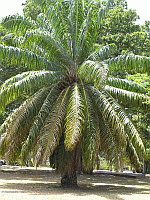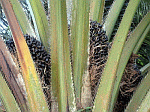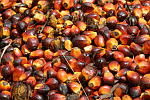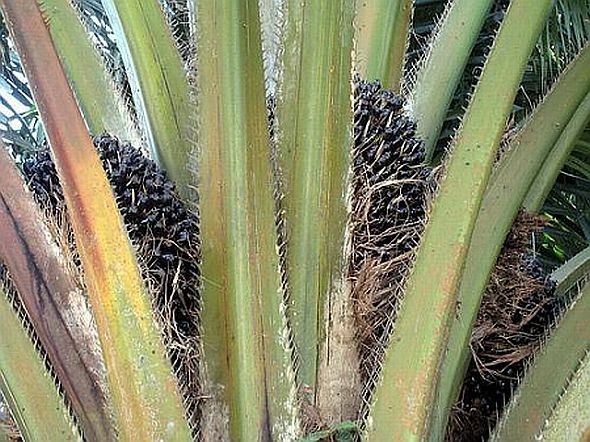


|

Geoff Leeming
Description: With the Coconut and Date palms, one of the three most important of the Palm family; stately, erect and handsome, up to 22 m tall (70 ft), usually less, with stout trunk, 30 cm diameter (12 in); leaves large, feathery and pinnately compound, 4.5-7.5 m long (15-24 ft), petioles (leaf bases) with saw-toothed thorns on margins; leaflets 100-150 pairs, 60-120 cm long (2-4 ft) and 3.5-5 cm broad (1.4-2.0 in); flowers set close to trunk in lower leaf axils, have separate male and female inflorescences, male in short clusters on inflorescence branches 10-15 cm long (4-6 in), female clusters are larger, bearing 200-300 flowers which eventually form the fruit bunches; fruits ovoid-oblong, about 3.5 cm long (1.4 in) and 2 cm wide (0.8 in), orange, red or black when ripe; palm oil produced from fleshy pericarp around seed; this oil naturally reddish due to high beta-carotene content; the more valuable palm kernel oil produced from white kernel within seed, similar to coconut oil; both oils high in saturated fatty acids, palm oil - 50%, and palm kernel oil - 80%; Gardens specimen, near Elmshall gate between cricket pitch and main road, is not known to fruit; fruit photos here are illustrative.
Plant Family: Belongs to the Arecaceae (Palmaceae) or Palm family, which includes Coconut (Cocus nucifera) and Date Palm (Phoenix dactylifera).
Natural Habitat: Thrives in hot humid climate on low-lying alluvial soil, ranging from savanna to rain forest, and on a wide range of tropical soils; propagation is by seed, germination in 4-8 months, but hastened by soaking in boiling water; bearing begins in 2-6 years, with full production between 12 and 30 years.
Origin and Distribution: Native to West Africa, especially S. Nigeria; introduced and cultivated throughout tropics, with plantations in Malaysia, Indonesia, Philippines, Honduras and Columbia, among others; and sometimes seen as an ornamental, as in south Florida.
Uses: Both palm oil and palm kernel oil widely used indigenously, and important commercially and in world trade; palm oil uses include manufacture of margarine, cooking oil, soaps and candles, as a lubricant, in biodiesel fuel, and as a surface protector in tin plate manufacture; palm kernel oil uses also include manufacture of margarine and cooking oil, and in ice cream and mayonnaise, baked goods and confectioneries, and in manufacture of soaps and detergents; the residual kernel cake used for stock feed; palm wine or toddy made from the fermented sweet sap of the male inflorescence; the soft heart of the leafy upper section of the stem is eaten as palm cabbage; leaves used to thatch huts; sometimes grown as ornamental, as in south Florida; medicinally, oil rich in carotene, and can be used in place of cod liver oil for correcting Vitamin A deficiency, and as a liniment; in indigenous folk medicine, reportedly used as an aphrodisiac and diuretic, and as a remedy for cancer, headache and rheumatism.
Indigenous Legends and Anecdotes: Palm Oil used in Africa for thousands of years, for cooking and in local medicines.
References:
Arlington A. James. An Illustrated Guide to Dominica’s Botanic Gardens. Forestry, Wildlife and Parks Division, Ministry of Agriculture, Dominica 2007
Anon. [Joseph Jones?]. Official Guide to the Botanic Gardens, Dominica. Kew Gardens, London 1924?
H.F. Macmillan. Tropical Planting and Gardening. Macmillan, London 1956
Julia F. Morton. Fruits of Warm Climates. Julia F. Morton, Miami, FL. 1987
|



